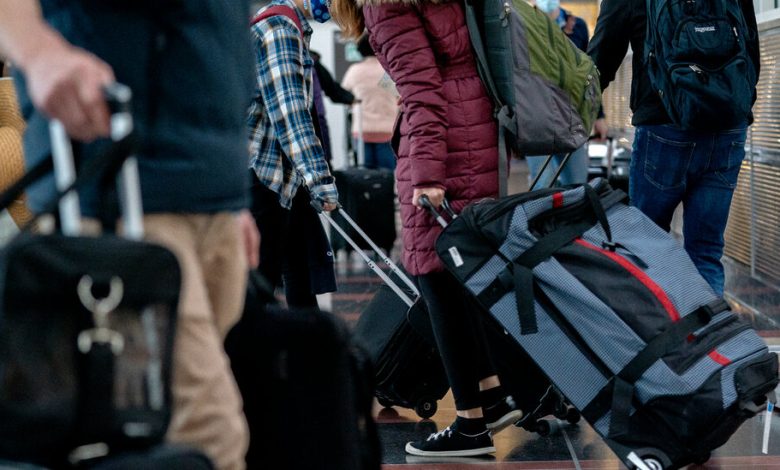Sharp Drop in Airfares Cheers Inflation-Weary Travelers

Airfares to many popular destinations have recently fallen to their lowest levels in months, and even holiday travel is far cheaper than it was last year, providing some welcome relief to consumers who have been frustrated for months by high prices for all manner of goods and services.
The glut of deals suggests that the airline industry’s supercharged pandemic recovery may finally be slowing as the supply of tickets catches up and, on some routes, overtakes demand, which appears relatively robust.
Consider the fares that Denise Diorio, a retired teacher in Tampa, Fla., recently scored. She spent less than $40 on flights to and from Chicago and paid just $230 for a round-trip ticket from New York to Paris and back, a trip she plans to take this month.
“I’ve been telling all my friends, ‘If you want to go somewhere, get your tickets now,’” she said.
The bargains she found may be exceptional, but Ms. Diorio is right that deals abound.
Early this month, the average price for a domestic flight around Thanksgiving was down about 9 percent from a year ago. And flights around Christmas were about 18 percent cheaper, according to Hopper, a booking and price-tracking app. Kayak, the travel search engine, looked at a wider range of dates around the holidays and found that domestic flight prices were down about 18 percent around Thanksgiving and 23 percent around Christmas.
“In a lot of cases, we’re seeing some of the lowest fares that we’ve seen really since travel started coming back after the drop-off in 2020,” said Kyle Potter, executive editor of Thrifty Traveler, a travel blog and deal-watching service.
Domestic ticket prices fell over the summer, Mr. Potter said, and deals on international travel, particularly to Europe, have become more common recently.
Airlines lower their fares when they are trying to get more people to book tickets as demand is slowing or they are facing stiffer competition. There’s little question that competition has intensified on some routes, but travel experts say it’s not clear whether demand is waning.
Thanksgiving this year is expected to set a record for air travel, with nearly 30 million passengers forecast, according to Airlines for America, an industry group. That would be about 9 percent more than last year and 6 percent more than in 2019, before the pandemic.
But some airlines say demand is slowing outside of holiday and other peak travel periods. In addition, some airports have been so flooded with flights that carriers have been forced to cut fares to fill planes.
That hadn’t been much of a problem for most of the recovery from the pandemic. Weather and other disruptions limited the supply of flights last year and in 2021, as did shortages of trained pilots, parts and planes, among other factors. That drove up ticket prices, kept planes full and helped airlines take in strong profits.
“The airline industry has never delivered the types of profit margins and return on capital that it has done over the last 2.5 years,” said John Grant, chief analyst with OAG, an aviation advisory and data firm. “We’re getting back to a more normal industry.”
For the largest U.S. airlines, the good times have continued, fueled in particular by thriving demand for international travel. But smaller and low-fare carriers have started to suffer. Several reported disappointing financial results for the three months that ended in September. Executives at those airlines have said demand is weakening, fares are falling and costs remain high. They also say bad weather and a shortage of air traffic controllers have made flying more difficult.
JetBlue Airways, for example, lost $153 million in the third quarter, compared with a $57 million profit in the same period last year. The company said recently that it was moving flights away from crowded markets, such as New York, to those where it expected stronger performance, such as the Caribbean. The budget carriers Spirit Airlines and Frontier Airlines recently told investors that they were looking to cut costs by tens of millions of dollars.
Competition has been fierce in some important markets, driving down fares and profits.
In Denver, where Frontier is based, about 14 percent more seats were available on flights this summer than in the summer of 2019, according to Cirium, an aviation data provider. Miami and Orlando, Fla., two popular destinations served by many budget carriers, saw even larger increases in capacity.
But while airlines added flights in popular markets as they chased passengers, airports in other cities, including Los Angeles, a hub for several major airlines, had large declines in capacity from the summer of 2019.
“You’ll find that there’s a large correlation between the airlines that are doing well and the ones that are struggling, margin-wise, when you compare where their concentrations are,” Barry Biffle, Frontier’s chief executive, said last month on a conference call to discuss the airline’s third-quarter results.
When it comes to international routes, analysts are less certain of why fares are falling and whether they will remain low. The kinds of deals that Ms. Diorio got for her Paris trip could mean that larger airlines soon find themselves facing a financial squeeze or merely that the industry is returning to a prepandemic normal.
“Historically, demand to Europe softens in the winter,” said Steve Hafner, Kayak’s chief executive. “So I think that reflects normal trends.”
But demand for international travel could face challenges, partly because of the wars in the Middle East and Ukraine. Analysts also warn that many consumers may be less willing or able to splurge on travel than they were in the last couple of years, when they had pandemic savings to draw from. Even if demand remains strong, airlines risk offering too many seats on popular overseas routes.
Whatever the cause of the recent drop in fares, the deals are a welcome break to travelers from years of high prices, Mr. Potter said.
“Either way the recipe is there for cheap flights,” he said. “If it’s just a little bit of overcapacity, that’s a win for consumers. If travel demand is dropping, in some ways that’s an even bigger win for people who are never going to give up on travel.”




